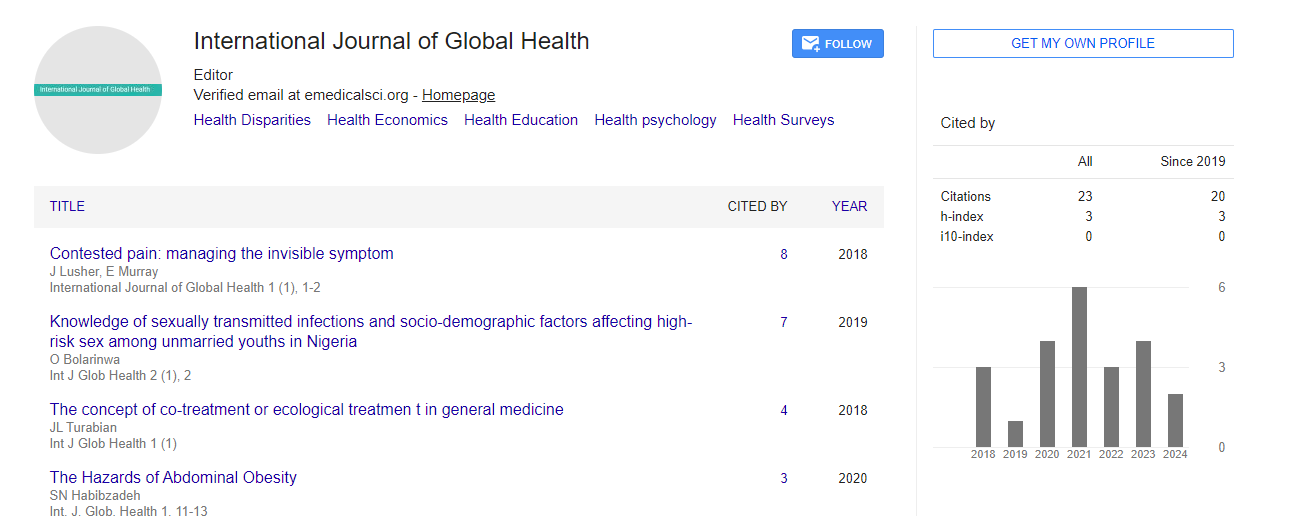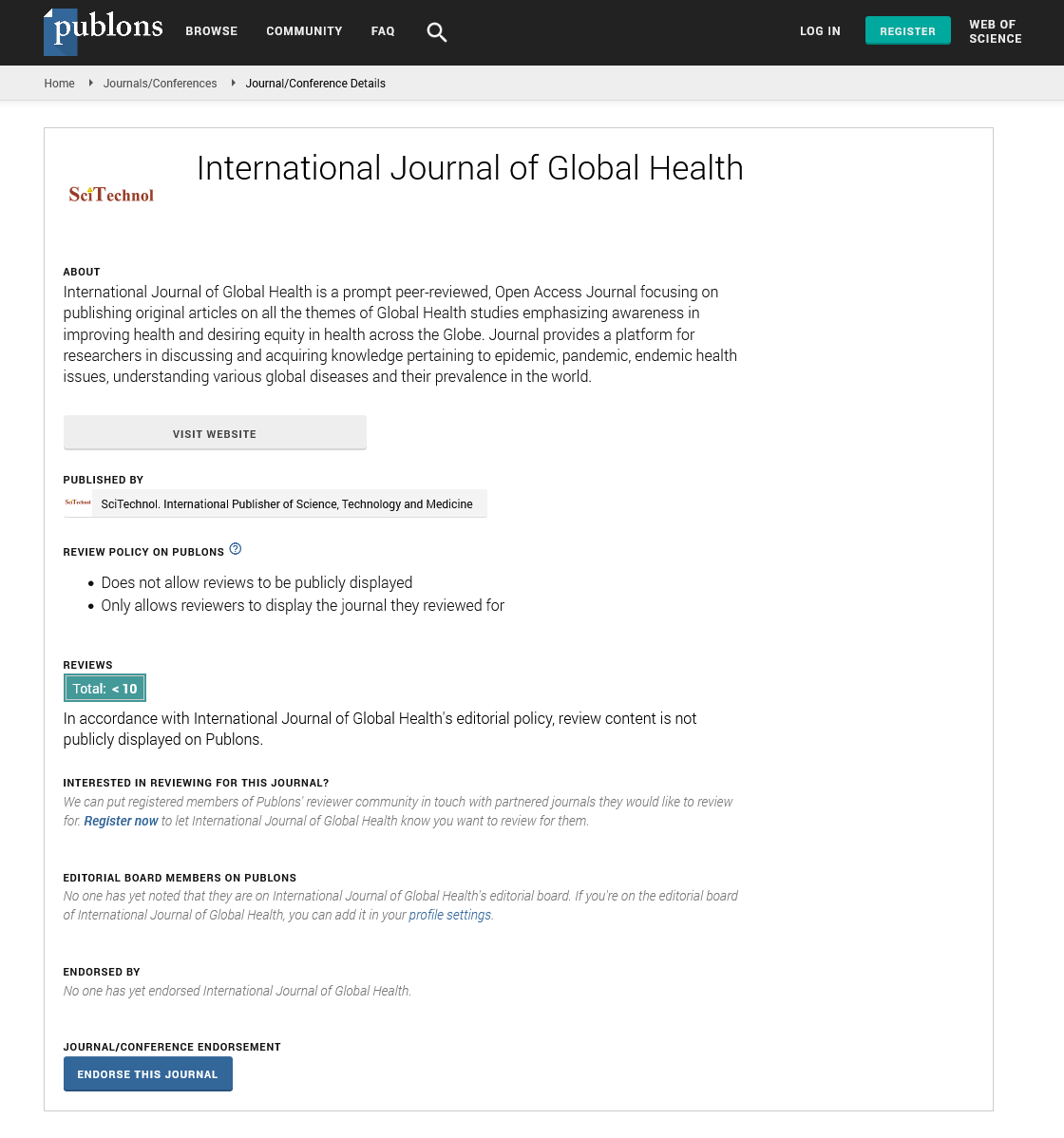Commentary, Int J Glob Health Vol: 6 Issue: 3
The Socioeconomic Determinants of Persistent Poverty
Dimitri Nikov*
1Department of Economics, Islamic University in Uganda, Mbale, Uganda
*Corresponding Author: Dimitri Nikov,
Department of Economics, Islamic University in Uganda, Mbale, Uganda
E-mail: dimitri.nikov@123iu.ug
Received date: 28 August, 2023, Manuscript No. IJGH-23-116161;
Editor assigned date: 30 August, 2023, PreQC No. IJGH-23-116161 (PQ);
Reviewed date: 13 September, 2023, QC No. IJGH-23-116161;
Revised date: 21 September, 2023, Manuscript No. IJGH-23-116161 (R);
Published date: 29 September, 2023, DOI: 10.4172/Ijgh.1000192
Citation: Nikov D (2023) The Socioeconomic Determinants of Persistent Poverty. Int J Glob Health 6:3.
Description
Persistent poverty is a complex and deeply entrenched issue that affects individuals, families, and communities around the world. Understanding the socioeconomic determinants of persistent poverty is essential for developing effective strategies to alleviate this condition and promote economic mobility [1-4].
Socioeconomic determinants of persistent poverty
Limited access to quality education: Individuals with limited access to quality education face lower educational attainment, which can limit their job prospects and earning potential. Persistent poverty often spans generations, with children born into poverty facing fewer opportunities for quality education, perpetuating the cycle.
Unemployment and underemployment: In areas with high poverty rates, job opportunities may be scarce, leading to chronic unemployment or underemployment. Those who do find work may be limited to low-wage jobs with minimal benefits, making it challenging to escape poverty [5,6].
Healthcare disparities: Persistent poverty is associated with reduced access to healthcare services, leading to unmet health needs and increased healthcare costs. Poor health can exacerbate poverty by limiting individuals' ability to work and increasing medical expenses.
Housing insecurity: Rising housing costs can lead to housing insecurity and homelessness for those in poverty. Many individuals in persistent poverty live in substandard housing, which can have negative effects on health and well-being.
Limited access to financial resources: Those in poverty may have limited access to credit and financial services, making it difficult to save, invest, or start a business. High-interest loans and debt can further trap individuals in poverty, as they struggle to repay loans with limited income [7-9].
Social and environmental factors: High-crime neighborhoods can create an unsafe environment, limiting economic opportunities and social mobility. Living in areas with poor environmental conditions can contribute to health problems and reduce overall well-being.
Social isolation: Individuals in persistent poverty may have limited access to social networks that could provide support and opportunities for economic advancement. Stigmatization and discrimination can further isolate individuals in poverty, reducing their chances of escaping it.
Geographic disparities: Persistent poverty is not limited to urban areas; rural poverty is a significant issue with unique challenges, including limited access to jobs and services. Economic disparities can vary significantly by region, with certain areas experiencing higher poverty rates [10].
Breaking the cycle of persistent poverty
Addressing persistent poverty requires a multifaceted approach that includes:
1. Improving educational access and quality, including early childhood education and vocational training, can empower individuals to secure better employment opportunities.
2. Creating jobs, providing skills training, and supporting small businesses can increase economic mobility.
3. Expanding healthcare access and preventive services can reduce healthcare-related poverty traps.
4. Policies promoting affordable housing and addressing homelessness can stabilize families and improve their wellbeing.
5. Expanding access to financial services and promoting financial literacy can help individuals manage their finances effectively.
6. Investing in safe and supportive communities can reduce social isolation and violence, creating a conducive environment for economic advancement.
7. Implementing policies that address income inequality, raise the minimum wage, and provide a social safety net can reduce persistent poverty.
8. Engaging affected communities in decision-making processes and supporting grassroots initiatives can empower individuals and families.
Conclusion
Persistent poverty is a multifaceted problem with deep-rooted socioeconomic determinants. Breaking the cycle of poverty requires a comprehensive approach that addresses education, employment, healthcare, housing, financial inclusion, and community development. By understanding and addressing these determinants, societies can work toward reducing persistent poverty and promoting economic mobility for all.
References
- Baker EH (2014) Socioeconomic status, definition. The Wiley Blackwell encyclopedia of health, illness, behavior, and society 6:2210-2214.
- House JS, Kessler RC, Herzog AR (1990) Age, socioeconomic status, and health. Milbank Q 1:383-411.
- Adler NE, Ostrove JM (1999) Socioeconomic status and health: what we know and what we don't. Ann N Y Acad Sci 896(1):3-15.
- Glymour MM, Avendano M, Kawachi I (2014) Socioeconomic status and health. Soc Epidemiol 2:17-63.
- McLaren L (2007) Socioeconomic status and obesity. Epidemiol Rev 29(1):29-48.
- Atkinson AB (1987) On the measurement of poverty. J Econom Soc 1:749-764.
- Deaton A (2006) Measuring poverty. Understanding poverty 20:3-15.
- Holmes EA, O'Connor RC, Perry VH, Tracey I, Wessely S et al (2020) Multidisciplinary research priorities for the COVID-19 pandemic: a call for action for mental health science. Lancet Psychiatry 7(6):547-60.
- Creswell JW, Klassen AC, Plano Clark VL, Smith KC (2011) Best practices for mixed methods research in the health sciences. Bethesda (Maryland): National Institutes of Health 2013:541-5.
- Smith B, Williams O, Bone L, Collective TM (2023) Co-production: A resource to guide co-producing research in the sport, exercise, and health sciences. Qual Res Sport Exerc Health 15(2):159-187.
 Spanish
Spanish  Chinese
Chinese  Russian
Russian  German
German  French
French  Japanese
Japanese  Portuguese
Portuguese  Hindi
Hindi 
